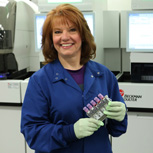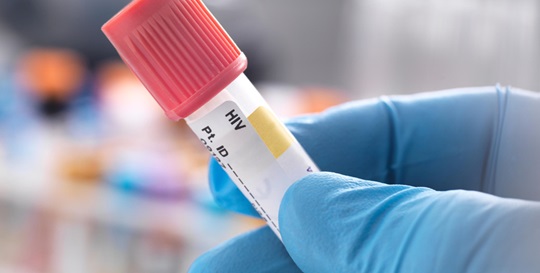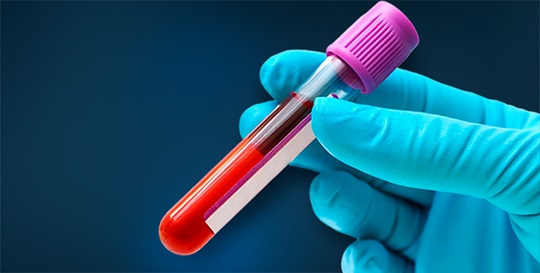Like most healthcare workers, I entered clinical laboratory science to help people, using my own individual talents, skills, and interests to help create an atmosphere in which people seeking help could feel safe, protected, and comforted.
As a hematology specialist and clinical education coordinator at Sarah Bush Lincoln Health Center in Mattoon, Ill., little did I know that the person in need of comfort would be me.
My father, Leonard Balsis, was my hero. I am the third of three children, the “bonus child” born ten and twelve years, respectively, after my two sisters. Daddy was an Illinois State Trooper, the Ranger Officer for District 10, headquartered in Pesotum, Ill. He was also District 10’s first Breathalyzer operator, a member of the Riot Squad and a Master Marksman. As you can imagine, when my two sisters were young, he spent a great deal of time building that career.
When I came along, in daddy’s eyes, I was special. Long story short, I became the son he never had. At daddy’s hand, I learned to catch a bluegill for my supper, how to knock a squirrel out of a tree with .22 caliber rifle at 100 yards, and yes, even, to wallop any little boy who dared try to kiss me on the playground (that all changed later!). We were inseparable. And this was a man who was truly beloved in his community, who knew literally everyone, from the purported Mafia hitman (really!) to the local powers-that-be, so I, too, moved freely and comfortably through all the levels of the society of my hometown and county. Daddy helped me become the person I am today, and he did it by example: use common sense, treat all people fairly, and treasure personal integrity above all else. All skills necessary for life, and, eventually, for a career spent helping other people.
Time passed, I grew up, married and had my daughter, Kelley. Unfortunately, my marriage didn’t work out, and I found myself a single working mother. Guess who stepped up to the plate? Yes, my daddy, Kelley’s beloved Grampy. I was privileged to now watch him take her under his wing, just as he had me.
Losing a Loved One to Sepsis
On July 7, 1998, daddy went to see his doctor. Now, I don’t know about you, but we health care providers and public servants tend to make the worst patients. We don’t want to admit vulnerability, we’ve seen things from both sides of the coin (sometimes not so favorably), and oftentimes, we’re just plain old stubborn people. And so, this was the case with daddy.
He had a boil. Who goes to see his doctor over a boil? But the thing just wouldn’t heal, and what we didn’t know was that the boil, as unassuming as it looked, had become septic without anyone, even daddy, realizing it. Finally, my mom prevailed, and my dad went to see the doctor. He was asked to submit a urine sample, and so he’d complied. According to mom, who had accompanied him, he just didn’t look right when he came out of the restroom. Just minutes later, he went into complete cardiovascular arrest. And he never came back. Now, my family suddenly had a huge hole where the sun used to be, all of us being mere planets in the solar system who were duly arranged around that sun. Where do you go? What do you do? My poor mom couldn’t even drive, and she didn’t know how to pay a bill. I had to tell my five-year-old daughter that her “Grampy” would never read her another story, never be able to watch The Lion King with her, and never share a bag of Hershey’s Kisses with her again.
And me? I took a nose dive. Personally, I was a complete and utter wreck and anyone who knows me would say that’s not like me, since normally I am a take-charge kind of woman. I found myself crying at the weirdest and most unexpected of times, like when I broke down in the grocery store aisle after randomly stopping in front of their selection of pickled pigs’ feet in jars (one of daddy’s favorite snacks, yuck!).
Professionally, I floundered for a while too, and it took me literally years to get my mojo completely back.
Helping Others with Early Sepsis Detection
But I did get my mojo back. And that’s why, when I learned about Beckman Coulter’s Early Sepsis Indicator (ESId), well, I knew we had to have it in our lab—period. ESId is the only FDA-cleared hematology biomarker for sepsis. It can help to identify adult patients in the emergency department who have sepsis or are at increased risk of developing sepsis.
The ESId measures monocyte distribution width (MDW) to support prompt clinical decision making for this often-deadly condition. This sepsis parameter is available as part of a routine CBC with differential, enabling automatic reporting without adding to your workload.
The hematologist in me understands the intrinsic value of this new hematology biomarker and I so appreciate the beauty, simplicity, and efficacy of the MDW to support clinical decision making.
The health-care worker in me immediately grasps the importance to my patients. I went right in to bring the ESId into our clinical laboratory, and now that we have it, I'm diligently working to spread the news, and champion the use and application of the ESId among our ER patients, where so many of them initially enter the health care stream, wherefore, it helps to maximize delivery of the most prompt and direct care.
And the daughter in me—coming full circle with the life lessons I had with my beloved father—values common sense and keeping it simple. After losing my own father to sepsis, I now know how important early identification is as well as the need to simply deliver safety, comfort, and quality care.
Detecting sepsis is a challenge. Learn how MDW can play a valuable role in early sepsis detection.

 English
English





